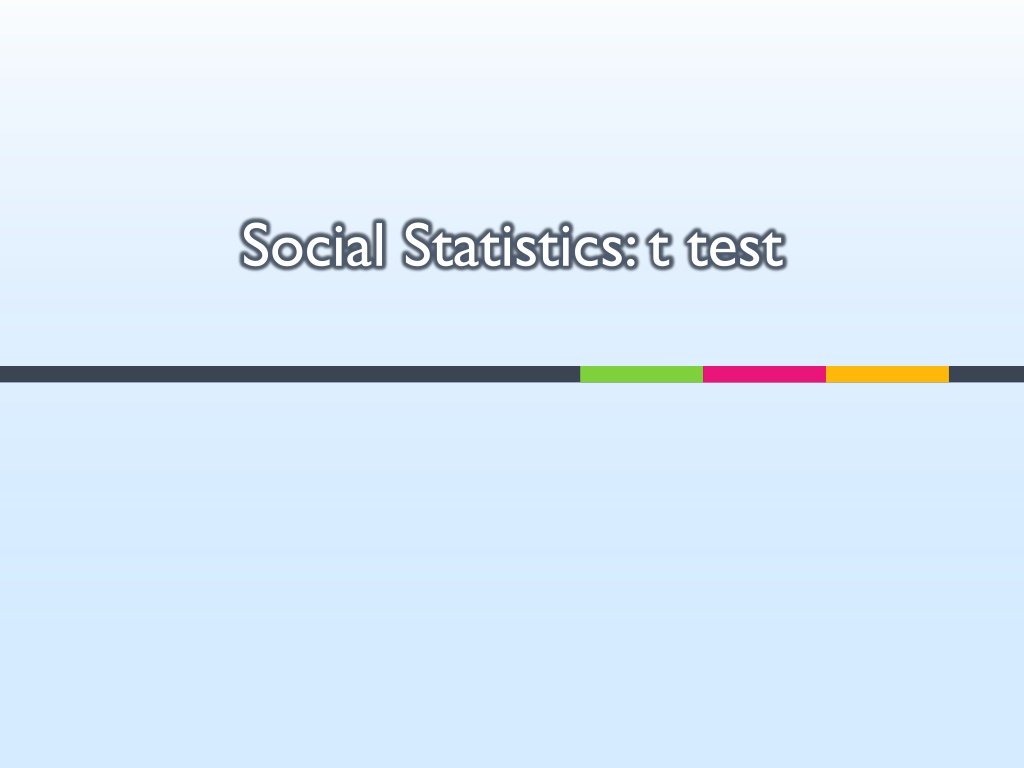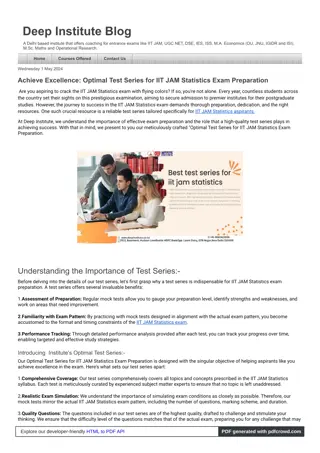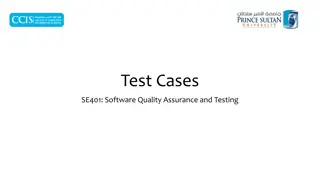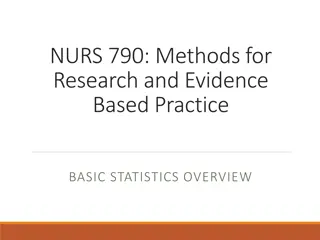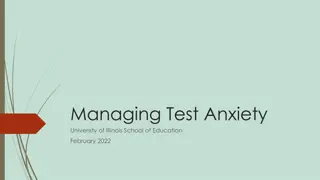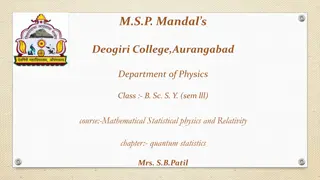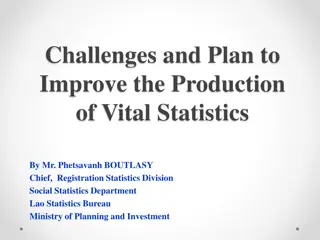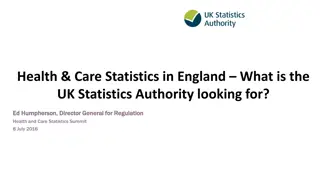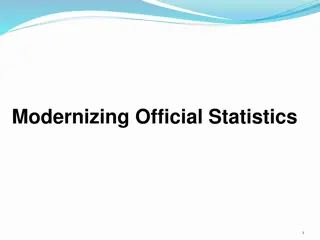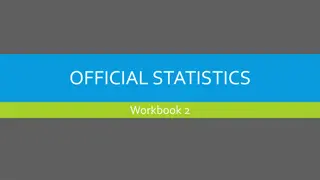The Basics of t-Test in Social Statistics
Explore the significance of the t-test for inferential statistics, its types, and why it is preferred over the z-test in many cases. Learn about William S. Gossett's contribution to the development of the t-test and understand concepts like degrees of freedom. Delve into practical applications with a detailed example involving hypothesis testing for babies' face stimulus recognition.
Download Presentation

Please find below an Image/Link to download the presentation.
The content on the website is provided AS IS for your information and personal use only. It may not be sold, licensed, or shared on other websites without obtaining consent from the author.If you encounter any issues during the download, it is possible that the publisher has removed the file from their server.
You are allowed to download the files provided on this website for personal or commercial use, subject to the condition that they are used lawfully. All files are the property of their respective owners.
The content on the website is provided AS IS for your information and personal use only. It may not be sold, licensed, or shared on other websites without obtaining consent from the author.
E N D
Presentation Transcript
This week What is t test Types of t test TTEST function T-test ToolPak 2
Why not z-test In most cases, the z-test requires more information than we have available We do inferential statistics to learn about the unknown population but, ironically, we need to know characteristics of the population to make inferences about it Enter the t-test: estimate what you don t know 3
William S. Gossett Employed by Guinness Brewery, Dublin, Ireland, from 1899 to 1935. Developed t-test around 1905, for dealing with small samples in brewing quality control. Published in 1908 under pseudonym Student ( Student s t-test ) 4
Degrees of Freedom and t test Degrees of freedom describes the number of scores in a sample that are free to vary. degrees of freedom = df = n-1 The larger, the better 6
One sample t test Very similar like z test Use sample statistics instead of population parameters (mean and standard deviation) Evaluate the result through t test table instead of z test table 7
An example We show 26 babies the two pictures at the same time (one with his/her mother, the other a scenery picture) for 60 seconds, and measure how long they look at the facial configuration. Our null assumption is that they will not look at it for longer than half the time, = 30 Our alternate hypothesis is that they will look at the face stimulus longer and face recognition is hardwired in their brain, not learned (directional) Our sample of n = 26 babies looks at the face stimulus for M = 35 seconds, s = 16 seconds Test our hypotheses ( = .05, one-tailed) 8
Step 1: Hypotheses Sentence: Null: Babies look at the face stimulus for less than or equal to half the time Alternate: Babies look at the face stimulus for more than half the time Code Symbols: 9
Step 2: Determine Critical Region Population variance is not known, so use sample variance to estimate n = 26 babies; df = n-1 = 25 Look up values for t at the limits of the critical region from our critical values of t table Set = .05; one-tailed tcrit = +1.708 10
Step 3: Calculate t statistic from sample Central Limit Theorem = 30 sM=s/ =16/ = 3.14 n 26 11
Step 4: Decision and Conclusion The tobt=1.59 does not exceed tcrit=1.708 We must retain the null hypothesis Conclusion: Babies do not look at the face stimulus more often than chance, t(25) = +1.59, n.s., one-tailed. Our results do not support the hypothesis that face processing is innate. 12
Independent t test A research design that uses a separate sample for each treatment condition is called an independent-measures (or between-subjects) research design. 13
t Statistic for Independent- Measures Design The goal of an independent-measures research study: To evaluate the difference of the means between two populations. Mean of first population: 1 Mean of second population: 2 Difference between the means: 1- 2 14
t Statistic for Independent- Measures Design Null hypothesis: no change = no effect = no difference H0: 1- 2 = 0 Alternative hypothesis: there is a difference H1: 1- 2 0 15
T test formula x x = 1 n 2 t + n + n 2 1 2 2 ( ) 1 n ( ) 1 n s s n n 1 2 1 n 2 + 2 1 2 1 2 ?1: is the mean for Group 1 ?2: is the mean for Group 2 ?1: is the number of participants in Group 1 ?2: is the number of participants in Group 2 ?12: is the variance for Group 1 ?22: is the variance for Group 20 Value for degrees of freedom: df = df1 + df2 16
An Example Group 1 Group 2 7 3 3 2 3 8 8 5 8 5 5 4 6 5 7 1 9 2 5 2 5 4 4 5 5 7 8 8 9 8 3 2 5 4 4 6 7 7 5 6 4 3 2 7 6 2 8 9 7 6 10 10 5 1 1 4 3 12 15 4 17
T test steps Step 1: A statement of the null and research hypotheses. Null hypothesis: there is no difference between two groups 0: = H 1 2 Research hypothesis: there is a difference between the two groups 1: H 1 2 18
T test steps Step 2: setting the level of risk (or the level of significance or Type I error) associated with the null hypothesis 0.05 19
T test steps Step 3: Selection of the appropriate test statistic Determine which test statistic is good for your research Independent t test 20
T test steps Step 4: computation of the test statistic value t= 0.14 21
T test steps Step 5: determination of the value needed for the rejection of the null hypothesis T Distribution Critical Values Table 22
T test steps Step 5: (cont.) Degrees of freedom (df): approximates the sample size Group 1 sample size -1 + group 2 sample size -1 Our test df = 58 Two-tailed or one-tailed Directed research hypothesis one-tailed Non-directed research hypothesis two-tailed 23
T test steps Step 6: A comparison of the obtained value and the critical value 0.14 and 2.001 If the obtained value > the critical value, reject the null hypothesis If the obtained value < the critical value, retain the null hypothesis 24
T test steps Step 7 and 8: make a decision What is your decision and why? 25
Interpretation How to interpret t(58) = 0.14, p>0.05, n.s. 26
Excel: T.TEST function T.TEST (array1, array2, tails, type) array1 = the cell address for the first set of data array2 = the cell address for the second set of data tails: 1 = one-tailed, 2 = two-tailed type: 1 = a paired t test; 2 = a two-sample test (independent with equal variances); 3 = a two-sample test with unequal variances 27
Excel: T.TEST function It does not compute the t value It returns the likelihood that the resulting t value is due to chance (the possibility of the difference of two groups is due to chance) 28
Excel ToolPak Select t-Test: Two-Sample Assuming Equal Variances t-Test: Two-Sample Assuming Equal Variances Variable 1 5.433333333 11.70229885 Variable 2 5.533333333 4.257471264 Mean Variance Observations Pooled Variance Hypothesized Mean Difference df t Stat P(T<=t) one-tail t Critical one-tail P(T<=t) two-tail t Critical two-tail 30 30 7.979885057 0 58 -0.137103112 0.44571206 1.671552763 0.891424121 2.001717468 29
Effect size If two groups are different, how to measure the difference among them Effect size 1 X X = 2 ES SD ES: effect size : the mean for Group 1 : the mean for Group 2 SD: the standard deviation from either group X X 1 2 30
Effect size A small effect size ranges from 0.0 ~ 0.2 Both groups tend to be very similar and overlap a lot A medium effect size ranges from 0.2 ~ 0.5 The two groups are different A large effect size is any value above 0.50 The two groups are quite different ES=0 the two groups have no difference and overlap entirely ES=1 the two groups overlap about 45% 31
